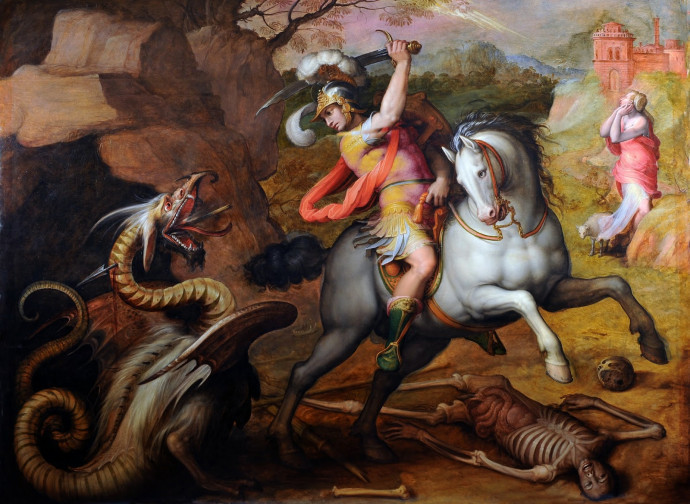Saint George
Saint George (c. 275 - c. 303) was already the object of an extensive and ancient cult long before the legendary image of his fight with the dragon, symbolizing the intrepid faith that triumphs over evil.

Saint George (c. 275 - c. 303) was already the object of an extensive and ancient cult long before the legendary image of his fight with the dragon, symbolizing the intrepid faith that triumphs over evil. His cult is in fact recorded since the fourth century, the period when his martyrdom took place, probably during the Great Persecution of Diocletian. The most ancient literary source about him is the Passio Georgii, judged apocryphal by the Decretum Gelasianum, a document traditionally attributed to Pope Gelasius (492-496). The Passio, besides dwelling on the miracles, reports that George was originally from Cappadocia and later moved to Palestine. Here he enlisted in Diocletian's army and became part of the emperor's guard until, the raging persecutions, when he suffered martyrdom by beheading. His steadfastness in Christ had meanwhile caused the conversion of the magister militum Anatolius and his soldiers, as well as the open profession of faith of the noble Alexandra: they were all martyred.
The story of his victory over the dragon only emerged around the 12th century and became extraordinarily popular from the following century, as it was included in the Legenda Aurea of Jacobus da Varagine and depicted by many artists. The deliverance of the maiden and of all the inhabitants who were subject to the power of the dragon is a beautiful image of liberation from sin and from the chains of the devil: “Do not fear, for the Lord has allowed me to free you from this monster. Believe, receive Baptism and I will kill your persecutor”, says George in the Legenda. In the meantime, the famous red cross on a white background, known as St. George's Cross, had become the symbol of the Crusaders and the Republic of Genoa, which then granted England the right to use it on its ships. England, whose King Edward III introduced the battle cry “Saint George for England!”, is one of the nations that has Saint George as its patron saint. He is also the protector of several knightly orders.
As mentioned, the cult of the saint had already taken root shortly after his death. This is proven firstly by the archaeological remains of the basilica built on the tomb of St. George in Lydda (Diospoli), Israel, dating back to the time of Constantine (†337), the emperor under whom Christians were finally granted the freedom to profess their faith. Secondly, a Greek epigraph found in Batanea, northeast of the River Jordan, and believed by the Bollandist Delehaye to date back to 368, speaks of a “house [or church] of the saints and triumphant martyrs George and companions”. The oldest testimony written on the tomb to reach us dates back to 530 and is by Theodosius Periegeta, who wrote: in Diospolim, ubi sanctus Georgius martyrizatus est, ibi et corpus eius est et multa mirabilia fiunt. It cannot be excluded, however, that the martyrdom took place at Nicomedia[1], where Diocletian resided at length, and that the martyr's body was later moved to Lydda, where his tomb remains today.
The great veneration at the site of Saint George's tomb led to the city of Lydda being renamed Georgioupolis under the Byzantine Empire. But, since the first centuries of Christianity, the cult of Saint George, whom the Orthodox worshiped with the title of “megalomartyr”, was certainly not limited to the area of Lydda, but spread from East to West: inscriptions, churches or monasteries dedicated to him were present since at least the 6th century in Jerusalem, Jericho, Mainz, Paris, Ravenna, Zorava. In Rome, General Belisarius (500-565) entrusted the protection of the city’s San Sebastiano Gate to St George; the first nucleus of the Church of St. George in Velabro was built in the same period. Two centurie s later, Pope Zechariah had the martyr's skull moved here.
Patron of: halberdiers, archers, gunsmiths, knights, English martyrs, scout movement, soldiers; invoked against skin diseases, plague and venereal diseases; Canada, England, Ethiopia, Georgia, Lithuania, Malta, Portugal.
[1] Among the sources that suggest this hypothesis is the Church History by Eusebius of Caesarea, completed around 323, where it speaks of the martyrs of Nicomedia and of a believer who tore up the persecutory edict against Christians.




